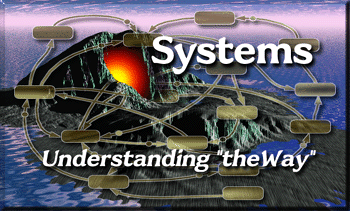Here are a few definitions about systems thinking, let's take a look:
Wikipedia:
Systems thinking is the process of understanding how things, regarded as systems, influence one another within a whole. In nature, systems thinking examples include ecosystems in which various elements such as air, water, movement, plants, and animals work together to survive or perish. In organizations, systems consist of people, structures, and processes that work together to make an organization "healthy" or "unhealthy". Systems thinking has roots in the General Systems Theory that was advanced by Ludwig von Bertalanffy in the 1940s and furthered by Ross Ashby in the 1950s. The field was further developed by Jay Forrester and members of the Society for Organizational Learning at MIT which culminated in the popular book The Fifth Discipline by Peter Senge which defined Systems thinking as the capstone for true Organizational learning. (1,2)Waters Foundation:
Systems thinking utilizes habits, tools and concepts to develop an understanding of the interdependent structures of dynamic systems. When individuals have a better understanding of systems, they are better able to identify the leverage points that lead to desired outcomes. (3)
“What do we mean when we say ‘systems thinking?’” We can use the phrase to refer to a set of tools – such as causal loop diagrams, stock and flow diagrams and simulation models – that help us map and explore dynamic complexity. We can also use it to mean a unique perspective on reality – a perspective that sharpens our awareness of whole and of how the parts within those wholes interrelate. Finally, systems thinking can refer to a special vocabulary with which we express our understanding of dynamic complexity. For example, systems thinkers often describe the world in terms of reinforcing and balancing processes, limits, delays, patterns of behavior over time, and so forth.” – Barry Richmond, isee systems, inc. (4)
“Systems thinking is a vantage point from which you see a whole, a web of relationships, rather than focusing only on the detail of any particular piece. Events are seen in the larger context of a pattern that is unfolding over time.”
isee systems, inc.(4)
Systems thinking is a perspective of seeing and understanding systems as wholes rather than as collections of parts. A whole is a web of interconnections that creates emerging patterns. (4)Mental Models:
Thwink:System
A system is an entity which maintains its existence
through the mutual interaction of its parts.The key emphasis here is one of "mutual interaction," in that something is occurring between the parts, over time, which maintains the system. A system is different than a heap or a collection, mostly. Emergence
Associated with the idea of system is a principle called emergence. From the mutual interaction of the parts of a system there arise characteristics which can not be found as characteristic of any of the individual parts.One has to study the system to get a true understanding of wetness. Studying the parts will not provide an appropriate understanding. (5)
Here's a definition from Barry Richmond, who coined the term in 1987: 1
Systems Thinking is the art and science of making reliable inferences about behavior by developing an increasingly deep understanding of underlying structure.Cultivating this "art and science" leads to routine use of correct mental models that see the world as a complex system whose behavior is controlled by its dynamic structure, which is the way its feedback loops interact to drive the system's behavior. The term systems thinking is preferred to holistic or whole systems, which have looser and more intuitive meanings, and emphasize understanding the whole rather than the dynamic structure of the system.
Systems thinking is not stepping back to look at the whole, the big picture, or a higher level. Nor is it realizing that when a butterfly flaps its wings in one place, that could cause a hurricane far away. This helps, but does not lead to the major insights that emerge when the feedback loop structure of the system becomes visible. When this happens night becomes day. Systems thinking is the first step to an even higher level: system dynamics, where instead of just thinking in terms of system structure you model it.(6)
References
- http://en.wikipedia.org/wiki/Systems_thinking
- Senge, Peter (1990). The Fifth Discpline. Doubleday.
- http://watersfoundation.org/systems-thinking/what/
- http://watersfoundation.org/systems-thinking/definitions/
- http://www.systems-thinking.org/index.htm
- http://www.thwink.org/sustain/glossary/SystemsThinking.htm

No comments:
Post a Comment